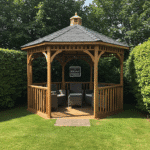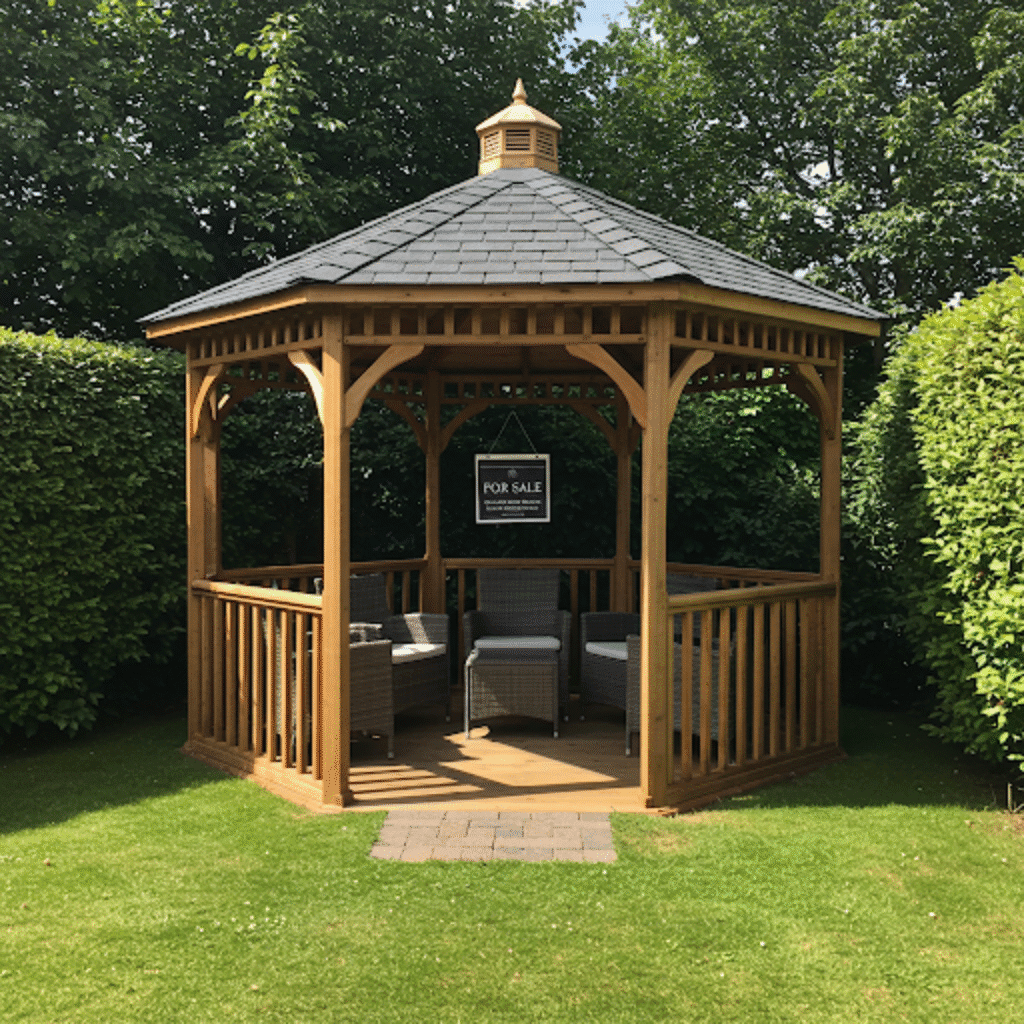
Transform Your Garden: The Ultimate Guide to Finding Gazebos for Sale
Dreaming of lazy summer afternoons spent lounging in the shade, elegant garden parties sheltered from unexpected showers, or simply a beautiful focal point for your outdoor space? A gazebo might just be the perfect addition to your UK garden. More than just a structure, a gazebo offers a versatile haven, extending your living space into the great outdoors and providing countless opportunities for relaxation and entertainment. But with so many options available, navigating the world of ‘gazebos for sale’ can feel overwhelming. Fear not! This comprehensive guide will walk you through everything you need to know to find the ideal gazebo to enhance your garden and lifestyle.
What Exactly is a Gazebo?
Before diving into the specifics, let’s clarify what we mean by ‘gazebo’. Traditionally, a gazebo is a freestanding, roofed structure, open on most or all sides. They often feature a raised floor and sometimes built-in seating, providing shelter, shade, and an ornamental feature within a garden or park. Think of bandstands in public parks – those are classic gazebos!

While often confused with pergolas (which typically have an open-rafter roof designed for climbing plants) or pavilions (which can be larger and more varied in design), the defining characteristic of a gazebo is its solid roof providing reliable shelter from sun and rain, combined with its open-sided or partially open-sided design offering panoramic views of the surroundings.
Why Welcome a Gazebo into Your Garden? The Benefits Abound
Investing in a gazebo offers a wealth of advantages that go far beyond simple aesthetics:
- Essential Shade and Shelter: In the unpredictable British weather, a gazebo provides invaluable protection. It offers cool shade on sunny days and a dry retreat during sudden downpours, allowing you to enjoy your garden more often.
- The Perfect Entertaining Hub: Host garden parties, barbecues, or intimate alfresco dinners under the shelter of your gazebo. It creates a defined, inviting space for guests to gather.
- A Peaceful Retreat: Create your own private sanctuary for reading, relaxing, or simply enjoying a quiet cup of tea amidst the beauty of your garden.
- Enhancing Garden Aesthetics: A well-chosen gazebo acts as a stunning focal point, adding structure, elegance, and character to your landscape design.
- Increasing Property Value: A high-quality, permanent gazebo can be seen as a desirable feature, potentially adding value to your home should you decide to sell.
- Versatility: From hot tub enclosures to outdoor yoga studios, the uses for a gazebo are limited only by your imagination.
Navigating the Types: Finding Your Perfect Match
Gazebos come in various styles, primarily differing in their permanence and roof type. Understanding these differences is key to finding one that suits your needs and budget.
Pop-Up Gazebos (Temporary)
Often the first type people think of, pop-up gazebos are designed for portability and temporary use. They typically feature a concertina metal frame and a fabric canopy.
- Pros: Highly portable, easy and quick to erect and dismantle, relatively inexpensive, ideal for occasional use (parties, camping, market stalls).
- Cons: Less durable, susceptible to wind damage if not anchored properly, fabric canopy offers limited longevity against constant UV exposure and harsh weather. Not suitable as a permanent fixture.
Permanent Gazebos
These are designed to be a long-lasting feature in your garden. They boast sturdier frames (wood, metal, vinyl) and more robust roofing systems.
- Pros: Highly durable and weather-resistant, can be used year-round, adds significant aesthetic and functional value, provides reliable shelter.
- Cons: More expensive, requires assembly (potentially professional installation), requires a permanent location and solid foundation.
Hardtop vs. Soft-top Gazebos
This distinction applies mainly to permanent or semi-permanent structures:
- Soft-top Gazebos: Feature a fabric canopy (like polyester or acrylic) stretched over a frame. These offer a more affordable entry point into permanent-style gazebos but the canopy will need replacing every few years depending on weather exposure.
- Hardtop Gazebos: Boast a solid roof made from materials like polycarbonate panels, metal sheets (steel or aluminium), or even traditional wooden shingles or tiles. These offer superior durability, weather protection, and longevity, but come at a higher price point.
Materials Matter: Choosing the Right Frame and Roof
The materials used in a gazebo’s construction significantly impact its appearance, durability, maintenance requirements, and cost. Let’s break down the common options:
Gazebo Frame Materials
- Wood: A timeless classic, offering natural beauty and warmth.
- Common Woods: Pressure-treated Pine (affordable, good decay resistance), Cedar (naturally resistant to insects and rot, beautiful colour, more expensive), Oak (very strong, durable, premium price).
- Pros: Aesthetically pleasing, strong and sturdy, can be painted or stained to match your garden style.
- Cons: Requires regular maintenance (staining, sealing) to prevent rot, warping, and insect damage, can be heavy and more expensive than some alternatives.
- Metal: Offers strength and durability with different characteristics depending on the type.
- Steel: Very strong and durable, often powder-coated for rust resistance.
- Aluminium: Lighter than steel, naturally rust-resistant, often used for both frames and hardtop roofs.
- Pros: Strong, durable, relatively low maintenance (especially aluminium), often offers a more modern aesthetic. Powder-coating adds colour choice and protection.
- Cons: Steel can rust if the coating is scratched or damaged, metal can absorb heat making the frame hot to touch in direct sun, potentially higher initial cost than basic wood or pop-ups.
- Vinyl/Resin: A practical, low-maintenance option.
- Pros: Highly resistant to weather, rot, and insects, requires minimal maintenance (just occasional cleaning), often available in white or neutral tones.
- Cons: Can sometimes look less ‘natural’ than wood, potential for fading or becoming brittle over many years in strong sunlight, generally less strong than wood or metal.
Gazebo Roof Materials
- Fabric/Canvas (Soft Tops): Typically polyester or acrylic, often treated for water and UV resistance.
- Pros: Lightweight, relatively inexpensive, replaceable canopy, wide range of colours.
- Cons: Least durable option, prone to fading, tearing, and mildew, needs removing/storing in harsh winter conditions, limited lifespan.
- Polycarbonate Panels (Hard Tops): Translucent or tinted rigid plastic panels.
- Pros: Lightweight yet strong, allows natural light through while blocking harmful UV rays, good weather resistance.
- Cons: Can become brittle or yellow over time with prolonged sun exposure, may require occasional cleaning to maintain clarity, can be noisy during heavy rain or hail.
- Metal Sheets (Hard Tops): Usually steel or aluminium panels.
- Pros: Very durable, excellent weather protection (sun, rain, snow), long lifespan, low maintenance.
- Cons: Can be noisy in rain, can radiate heat downwards in very hot sun (less so with lighter colours or vented designs), potentially higher cost.
- Wood Shingles/Tiles (Hard Tops): Offer a traditional, high-end look.
- Pros: Highly attractive, excellent durability and weather resistance, long lifespan.
- Cons: Heavy (requires a very sturdy frame), most expensive option, requires skilled installation, potential for moss growth requires maintenance.
Size and Shape: Planning Your Gazebo Space
Before you fall in love with a specific model, measure your intended location carefully. Consider:
- Available Space: Ensure enough room not just for the gazebo footprint, but also for comfortable access around it. Check for overhead obstructions like tree branches or cables.
- Intended Use: How many people do you want to accommodate? Will it house furniture like a dining set, lounge chairs, or a hot tub? A small bistro set might fit in a 2.5m x 2.5m gazebo, while a full dining area might need 3m x 4m or larger.
- Common Shapes:
- Square/Rectangular: Practical, easy to furnish, fits well in corners or along boundaries.
- Hexagonal/Octagonal: Classic, elegant shape, offers panoramic views, can be slightly trickier to furnish efficiently.
It’s often helpful to mark out the proposed footprint on your lawn or patio with string or spray paint to visualise the space it will occupy.
Don’t Forget the Features: Essential Extras and Accessories
Many gazebos come with or offer optional features that enhance functionality and comfort:
- Side Walls/Curtains: Provide privacy, block wind and driving rain, and offer extra shade. Look for sturdy attachments and durable, weather-resistant fabric.
- Mosquito Netting: Essential for enjoying summer evenings without unwelcome buzzing guests. Ensures airflow while keeping insects out.
- Roof Vents: Particularly important for hardtop and fabric gazebos, vents allow heat and wind to escape, improving comfort and stability. Double-tiered roofs often incorporate venting.
- Anchoring Kits: Crucial for safety and stability, especially for pop-up and lighter permanent structures. Ensure the gazebo is securely fixed to the ground (grass, decking, or patio) according to manufacturer instructions. Permanent structures need proper footings.
- Built-in Elements: Some premium gazebos feature integrated benches, counters, or planters.
- Lighting Hooks/Provision: A central hook or designated areas for adding outdoor lighting can extend usability into the evening.
Where to Find Gazebos for Sale in the UK
You have several options when searching for your perfect gazebo:
- Garden Centres & DIY Stores: National chains like B&Q, Homebase, Wickes, and numerous independent garden centres often have seasonal displays, allowing you to see models assembled. Stock may vary, and prices can be competitive during sales.
- Online Retailers: Websites like Amazon, Wayfair, Robert Dyas, and specialist outdoor living retailers offer a vast selection, often with detailed specifications and customer reviews. Compare prices and check delivery costs carefully.
- Direct from Manufacturers/Specialists: Some companies specialise in high-quality timber or metal gazebos, offering bespoke options or premium ranges. This is often the route for top-end, permanent installations.
When buying, especially online, check delivery timescales and costs (large items can be expensive to ship), warranty details, and the returns policy.
Understanding Gazebo Prices: What Influences the Cost?
Prices for gazebos vary enormously. Here’s what affects the final figure:
- Size: Larger gazebos naturally cost more due to increased materials.
- Materials: Pop-ups are cheapest, followed by soft-top fabric, then vinyl, basic metal/wood, polycarbonate hardtops, premium metals/woods, and finally tiled/shingled roofs.
- Brand/Retailer: Well-known brands or specialist suppliers may command higher prices.
- Features: Included side walls, netting, intricate designs, or built-in elements add to the cost.
- Permanence: Durable, permanent structures are a bigger investment than temporary ones.
- Installation: Factor in potential installation costs if you’re not doing it yourself.
Set a realistic budget, but remember that investing in better quality materials often pays off in longevity and reduced maintenance.
Installation: DIY Challenge or Professional Job?
Pop-up gazebos are designed for easy DIY assembly. Permanent gazebos, however, range in complexity.
- DIY Potential: Many kit-form permanent gazebos can be assembled by a competent DIYer with a helper or two. Instructions should be clear, but it requires time, patience, and the right tools. A perfectly level base (patio slabs, concrete pad, or sturdy decking) is crucial.
- Professional Installation: For large, heavy, or complex gazebos (especially timber or tiled roof models), or if you lack the time, tools, or confidence, professional installation is recommended. This ensures structural integrity and safety. Factor this cost into your budget.
Keeping Your Gazebo Glorious: Maintenance Essentials
To ensure your gazebo lasts for years and continues to look its best, regular maintenance is key:
- Regular Cleaning: Brush off leaves and debris. Clean frames and roofs according to manufacturer guidelines (usually mild soap and water). Keep fabric canopies clean to prevent mildew.
- Fabric Care: Store fabric canopies and side walls indoors during winter or severe weather to prolong their life. Check for and repair small tears promptly. Re-waterproof older canopies if necessary.
- Wood Treatment: Regularly inspect wooden gazebos for signs of wear, rot, or insect damage. Re-stain or re-seal every few years as needed to protect the timber.
- Metal Care: Check powder-coated steel for scratches and touch up paint to prevent rust. Aluminium requires less care but benefits from cleaning.
- Check Fixings: Periodically check that all bolts, screws, and anchors are secure, tightening as needed.
- Gutter Clearing: If your gazebo has gutters, keep them clear of leaves and debris.
A Quick Word on Planning Permission
In most cases, installing a typical garden gazebo in the UK does not require planning permission, as it falls under ‘permitted development’. However, there are exceptions, particularly concerning:
- Size: Very large structures might need permission.
- Height: Restrictions apply, especially near boundaries.
- Location: Rules differ for front gardens, conservation areas, or listed buildings.
If your planned gazebo is unusually large, tall, or positioned very close to a boundary, it’s always wise to check the specifics with your local council planning department for peace of mind. Generally, standard-sized gazebos placed reasonably within rear gardens are fine.
Beyond the Basics: Get Creative with Your Gazebo!
Think outside the box! A gazebo can be so much more than just a seating area:
- Outdoor Dining Room: Perfect for summer meals, protected from sun or showers.
- Hot Tub Enclosure: Provides privacy and shelter for year-round spa enjoyment.
- Garden Bar: Create a dedicated space for serving drinks during parties.
- Reading Nook or Artist’s Corner: A quiet, inspirational space surrounded by nature.
- Kids’ Play Zone: A shaded spot for outdoor toys and activities.
- Wedding or Event Backdrop: Decorate it for special occasions as a beautiful focal point.
- Yoga or Meditation Space: A tranquil setting for wellness activities.
Your Perfect Garden Getaway Awaits
A gazebo is a wonderful investment that can truly transform how you use and enjoy your garden. By carefully considering the types, materials, sizes, and features available, you can find the perfect structure to suit your space, style, and budget. Whether you opt for a simple pop-up for occasional parties or a stunning permanent hardtop for year-round enjoyment, the right gazebo will provide years of pleasure, offering shade, shelter, and an elegant focal point for your outdoor haven. Start exploring the gazebos for sale today and get ready to elevate your garden living experience.







